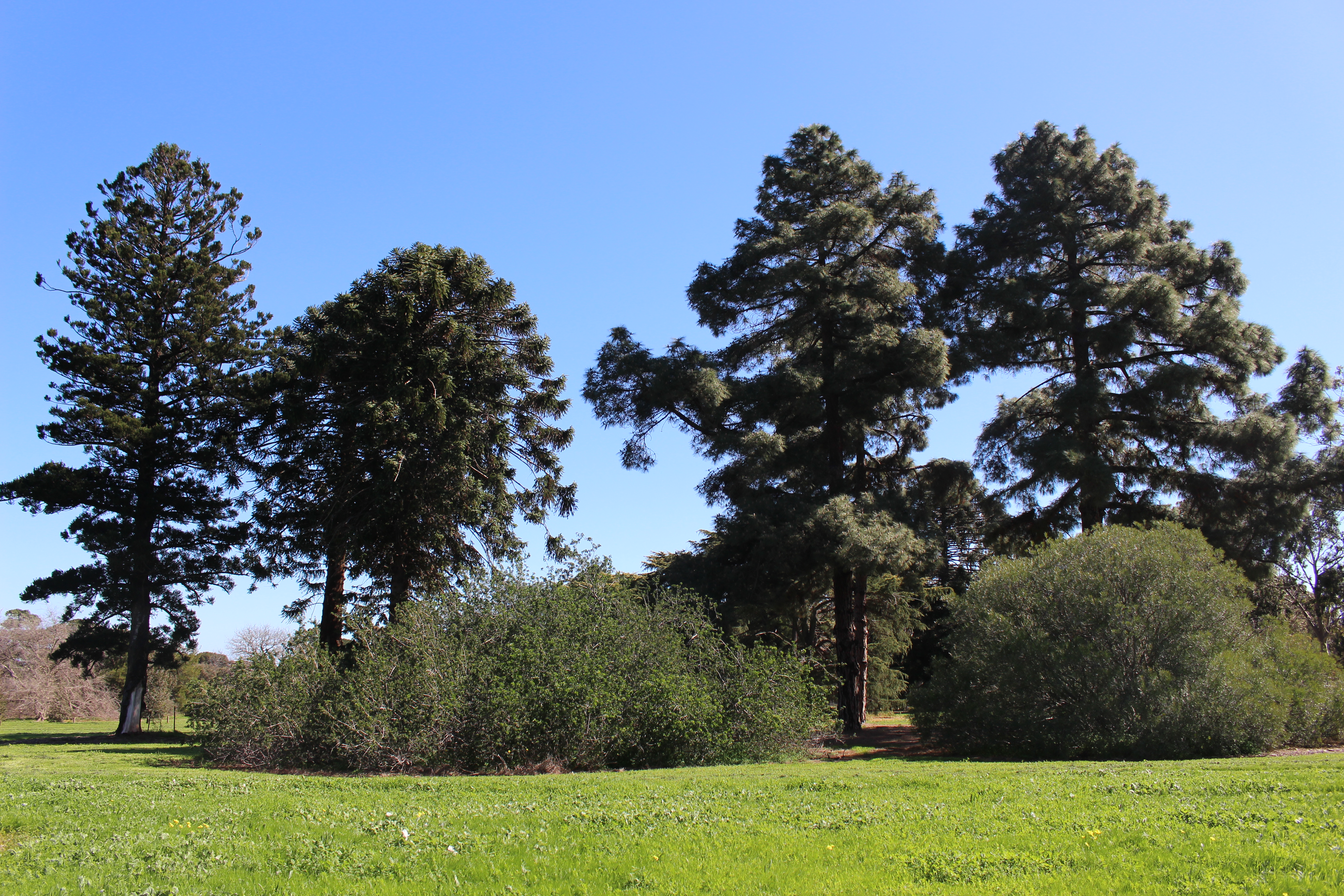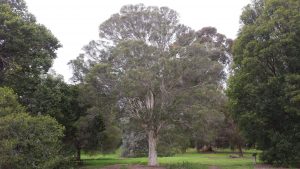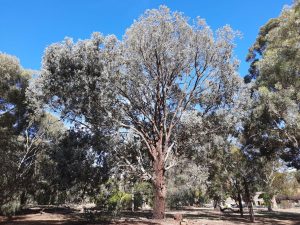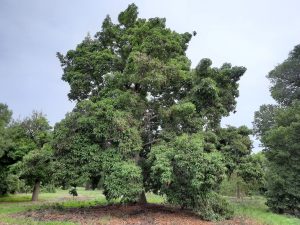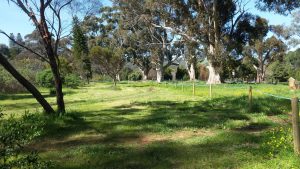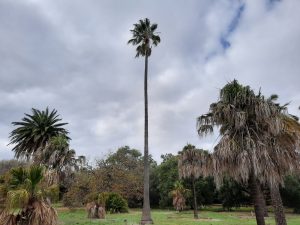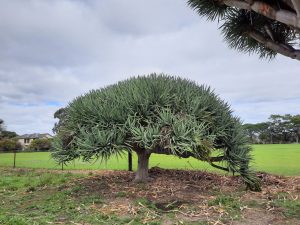Plant Collections
#173 Melaleuca styphelioides Prickly Paper-bark, planted in 1928
#135 Eucalyptus polyanthemos subsp. vestita Red Box, planted in 1938.
#6 Brachychiton x roseus Wentworth Flame Tree MALVACEAE PLANTED IN 1934
A view east in the Northwest Collection: Notice the Eucalyptus cladocalyx Sugar Gums, planted in 1877 and the soft rope fence installed in December 2019.
#405 Washingtonia robusta Thread Fan Palm, ARECACEAE Mexico 1928, 17 metres high (2019).
#1714 Dracaena draco subsp. caboverdeane ASPARAGACEAE Dragon Tree Cape Verde Islands 1960
Plant Collections – Tree species in the Arboretum
The Waite Arboretum – 27 hectares of 2,300 specimens representing more than 800 species in 200 genera all growing under natural yearly rainfall of 624mm.
Water management: Dr David Symon, Curator of the Waite Arboretum 1956 – 1986 took the decision not to water trees after established to see which species performed well on rainfall alone. The concept of homoclimes (regions that have similar climates) was used to guide the search selection of new trees for the Waite Arboretum from the 1950s.
Growth of plantings:
- In 1928 the first planting began and by 1930 1,020 trees had been planted representing 367 species in 180 genera and 67 families.
- In 1990 there was 1,560 trees representing 770 species in 202 genera.
- In 2020 there are over 2,300 trees representing 850 species.
Recent planting (2019 and 2020) have involved the participation of school students, university students, and community groups.
Plant Collections Include:
- Acacias
- Angophoras
- Araucarinas
- Banksias
- Bees, Birds and Butterflies
- Brachychitons
- Casuarinas and Allocasuarinas (sheoaks)
- Corymbia
- Dracaena: Around the world the the Dracaena genus has about 120 species of trees and shrubs. The arboretum's dracaena specimens can be found in a number of areas of the Arboretum as individual majestic single specimens, as unique collection along the Waite Oval fence line and the 'Baby' Dracaena collection near the Dr David Symon seat. The sword-like leaves of the dracaena make excellent basketry and weaving materials. #1715 Dracaena draco Dragon Blood's Tree is the tree used for Friends of the Waite Arboretum's logo. The scientific name of the Dracaena draco is derived from latin: dracaena (she – dragon) and draco dragon. The common name is linked to the deep the red colour of the dried sap of the Dragon Blood's Tree
- Dry Rainforest
- Eucalyptus cladocalyx: Sugar Gums were planted by Peter Waite along Walter Young Drive from Fullarton Road to Urrbrae House in 1877 (Gardner, 2015, p.12). Most of the trees were removed in 1959 and replaced with Corymbia citriodora, Lemon Scented Gums. The remaining 13 Sugar Gums are on the northern and southern western sections of the Arboretum and are over 32 metres in height. The trees have been part of a University of Adelaide student's honours year studies into European honey bees in 2019.
- Eucalypts: There are three areas of the Arboretum that have been planted with Eucalypts. The northwest section of the Arboretum was established in 1949 mainly for large species. The mallee collection was established in 1955. The third collection was established in 1993 – 1994 with volunteers growing and planting specimens from seeds collected in the wild by Dr Dean Nicole. In 2015 the Arboretum's Eucalypt collection of Eucalyptus, Corymbia and Angophora comprises 890 specimens representing 360 taxa (Gardner, 2015, p.12).
- DO EUCALYPTUS HAVE A PLACE IN THE URBAN FOREST OF TODAY AND TOMORROW ? How can we make this iconic Australian tree genus into a happy suburbanite? are 'designer trees" the Answer? Dr Kate Delaporte 2013. WAITE KATE D 2013 Treenet P LAIDLAW Pl do EUCALYPTS 480Kb
-
Juniperus
-
Mallee: 160 species of mallee specimens were planted in 1955. Small tree species were planted in triangles, the medium size trees in pairs and the taller species were planted as single specimens (Gardner, 1990, p.30).
-
Melaleucas (honey-myrtles):
-
Northwest section: The Arboretum prior to European settlement was a open savannah woodland. The northwest section contains original trees, Eucalyptus microcarpa Peppermint Box, Eucalyptus camaldulensis River Red Gum, and Eucalyptus leucoxylon Blue Gum.
- Ornamental Pears: In the mid 1960s Curator David Symon assembled the Waite Arboretum Pear Collection. In 2015, the collection comprised 91 specimens representing 30 taxa. Many of the selections were sourced from the wild. He recognised that ornamental pears (Pyrus ssp.) were far more drought tolerate, diesease resistant and more suited to Adelaide's climate than other deciduous genera that are often planted for their showry spring blossom (Gardner, 2015, p. 14).
- Palms and Cycads: H. Froehlingsdorf Palm and Cycad Walk, opened by Mr A Brady – Foundation President on 26 November 2000 – Palms and Cycads Society of South Australia. The Society began the first planting on 9th December 1994 and they continue with the Walk's regular volunteer maintenance and planting in 2020.
- Pinus: The collection includes Pinus torreyana Soledad Pine or Torrey Pine which a critically endangered species that is on the IUCN Red List
- Pyrus
- Quercus (oaks): "The 12 Californian species in the collection were introduced by Professor Prescott in collaboration with Professor Linsey Pryor who supervised the development of the Australian National Botanic Garden in Canberra between 1945 and 1958. The soil scientist Prescott and the botanist Pryor shared an interest in homoclimes" (Gardner, 2015, p.13).
VISIT the WAITE ARBORETUM APP for more information on the collections and individual specimens. https://friendsofwaitearboretum.org/features/arboretum-app/
